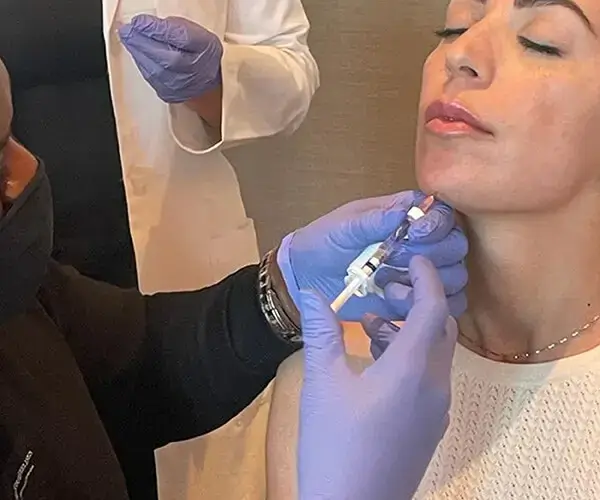Understanding Autologous Fat Transfer: Benefits & Process
By Dr. Stephen Cosentino
PRESIDENT OF EMPIRE MEDICAL TRAINING
Fat cells throughout the body share remarkable similarities, whether they're located in your thighs, cheeks, or breasts. This biological consistency forms the foundation for a popular cosmetic procedure known as autologous fat transfer. Plastic surgeons leverage this anatomical fact to enhance various body areas, offering patients a natural alternative to synthetic implants.
If you're contemplating body contouring, breast augmentation, or other cosmetic enhancements, first research how autologous fat transfers work. This article will explore the procedure's mechanics, potential outcomes, and associated risks.
What is Autologous Fat Transfer?
Autologous fat transfer, also known as fat grafting, is a minimally invasive procedure that relocates fat from one area of the body to another. It's important to note that while this procedure may sound similar to topics covered in a physician weight loss training course, it is not a weight loss solution. Instead, it's primarily used for cosmetic and reconstructive purposes.
Common Applications of Autologous Fat Transfer
- Breast augmentation or reconstruction
- Buttock augmentation (Brazilian Butt Lift)
- Facial rejuvenation
- Hand rejuvenation
- Correction of contour deformities
- Permanent lip augmentation
- Tummy tuck
- Hip augmentation
Additionally, autologous fat transfer is utilized in less invasive body contouring procedures that don't necessitate general anesthesia.
The Autologous Fat Transfer Procedure
The procedure typically occurs under general anesthesia, although more superficial treatments may only require local or "twilight" anesthesia. The duration can vary significantly, ranging from under an hour to over four hours, depending on the procedure's complexity and the volume of fat transferred.
Step-by-Step Process
- Fat Harvesting: The surgeon uses liposuction to extract the fat from donor areas, often the thighs, abdomen, or buttocks.
- Fat Processing: The harvested fat is purified and prepared for injection.
- Fat Injection: The processed fat is carefully injected into the target area for augmentation or reconstruction.
It's worth noting that "autologous fat grafting" is synonymous with autologous fat transfer. The terms are used interchangeably in the medical community.
Potential Risks and Complications
As with any surgical procedure, autologous fat transfer carries certain risks. Common side effects include temporary bruising, swelling, and minor bleeding around the incision sites. There's also a possibility that the procedure may not yield the desired results if the transferred fat cells fail to survive and are reabsorbed by the body.
More Serious Complications May Include:
- Infection
- Fat embolism
- Cysts
- Calcification
- Dizziness, nausea, and vomiting
- Sharp pain in or near the surgical wound
- Excessive bleeding or fluid leakage from the incisions
- Necrosis of fat or surrounding tissue
While these risks are real, recent studies suggest that the incidence of complications is relatively low compared to other aspects of plastic surgery. Nevertheless, working with a board-certified plastic surgeon who has completed an accredited autologous fat transfer training program is imperative. Avoid practitioners who exclusively specialize in non-surgical cosmetic interventions for this procedure.
Benefits of Autologous Fat Transfer
Despite the potential risks, autologous fat transfer offers several advantages:
- Natural Results: Using your own fat can provide a more natural look and feel compared to synthetic implants.
- Dual Benefit: The procedure can enhance one area while contouring another.
- Minimally Invasive: Compared to traditional implant surgeries, fat transfer typically involves smaller incisions and faster recovery times.
- Long-lasting Results: While some of the transferred fat may be reabsorbed, a significant portion often remains long-term.
Ideal Candidates for Autologous Fat Transfer
Not everyone is an ideal candidate for autologous fat transfer. The best candidates typically:
- Have adequate fat deposits in donor areas
- Are in good overall health
- Have realistic expectations about the procedure's outcomes
- Are non-smokers or willing to quit smoking before and after the procedure
- Have good skin elasticity in the recipient area
Recovery and Results
Recovery time varies depending on the extent of the procedure and the areas treated. Generally, patients can expect:
- Swelling and bruising for 1-2 weeks
- Return to light activities within a week
- Full recovery within 4-6 weeks
Initial results are visible immediately, but final results may take several months as swelling subsides and the transferred fat settles. It's important to note that not all transferred fat will survive long-term. Typically, 50-70% of the transferred fat remains permanent, while the body may reabsorb the rest.
Maintaining Your Results
To optimize and maintain the results of your autologous fat transfer:
- Maintain a stable weight
- Follow a healthy diet and exercise regimen
- Protect treated areas from excessive pressure during the healing process
- Avoid smoking, which can impair blood flow and fat cells' survival
- Follow all post-operative instructions provided by your surgeon
Conclusion
Autologous fat transfer is a versatile and increasingly popular procedure in plastic surgery. It offers a natural approach to body contouring and augmentation, with the potential for long-lasting results. However, like any surgical procedure, it comes with risks and requires careful consideration.
If you're considering autologous fat transfer, consult a board-certified plastic surgeon with extensive experience in this procedure. They can assess your individual case, discuss potential outcomes, and help you make an informed decision about whether this procedure is right for you.
Remember, while autologous fat transfer can provide significant aesthetic improvements, it's not a substitute for a healthy lifestyle. Maintaining a balanced diet, regular exercise routine, and overall wellness will always be key to looking and feeling your best.


